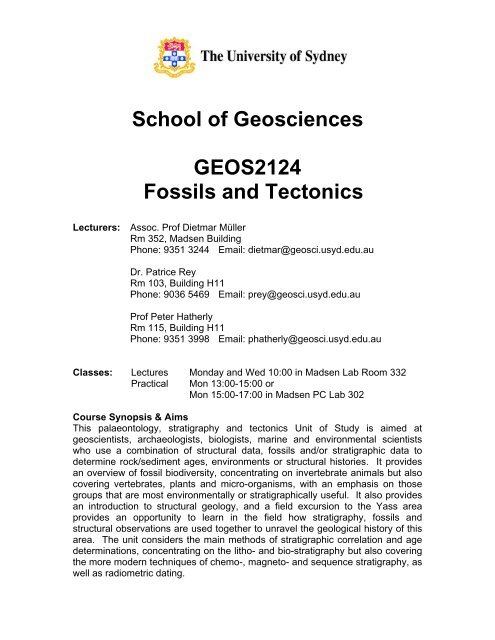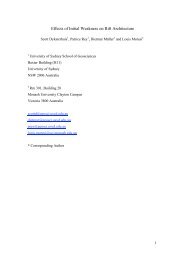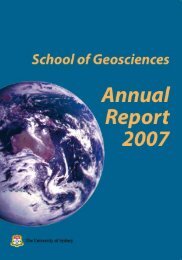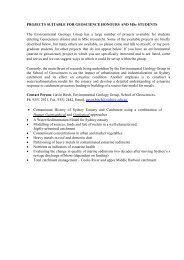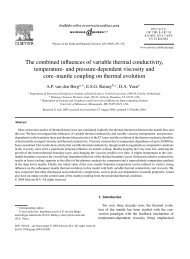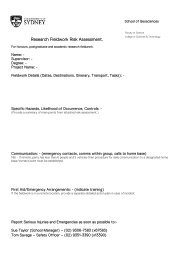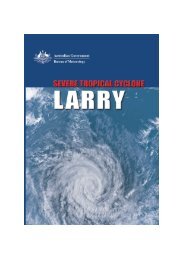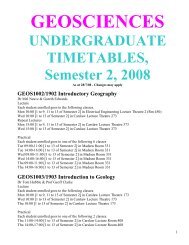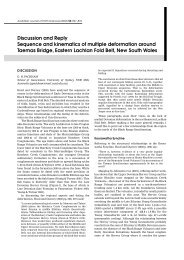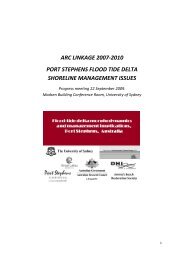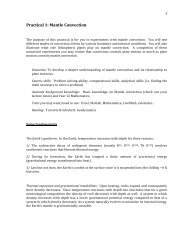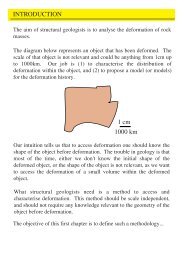School of Geosciences GEOS2124 Fossils and Tectonics
School of Geosciences GEOS2124 Fossils and Tectonics
School of Geosciences GEOS2124 Fossils and Tectonics
Create successful ePaper yourself
Turn your PDF publications into a flip-book with our unique Google optimized e-Paper software.
<strong>School</strong> <strong>of</strong> <strong>Geosciences</strong><br />
<strong>GEOS2124</strong><br />
<strong>Fossils</strong> <strong>and</strong> <strong>Tectonics</strong><br />
Lecturers: Assoc. Pr<strong>of</strong> Dietmar Müller<br />
Rm 352, Madsen Building<br />
Phone: 9351 3244 Email: dietmar@geosci.usyd.edu.au<br />
Dr. Patrice Rey<br />
Rm 103, Building H11<br />
Phone: 9036 5469 Email: prey@geosci.usyd.edu.au<br />
Pr<strong>of</strong> Peter Hatherly<br />
Rm 115, Building H11<br />
Phone: 9351 3998 Email: phatherly@geosci.usyd.edu.au<br />
Classes: Lectures Monday <strong>and</strong> Wed 10:00 in Madsen Lab Room 332<br />
Practical Mon 13:00-15:00 or<br />
Mon 15:00-17:00 in Madsen PC Lab 302<br />
Course Synopsis & Aims<br />
This palaeontology, stratigraphy <strong>and</strong> tectonics Unit <strong>of</strong> Study is aimed at<br />
geoscientists, archaeologists, biologists, marine <strong>and</strong> environmental scientists<br />
who use a combination <strong>of</strong> structural data, fossils <strong>and</strong>/or stratigraphic data to<br />
determine rock/sediment ages, environments or structural histories. It provides<br />
an overview <strong>of</strong> fossil biodiversity, concentrating on invertebrate animals but also<br />
covering vertebrates, plants <strong>and</strong> micro-organisms, with an emphasis on those<br />
groups that are most environmentally or stratigraphically useful. It also provides<br />
an introduction to structural geology, <strong>and</strong> a field excursion to the Yass area<br />
provides an opportunity to learn in the field how stratigraphy, fossils <strong>and</strong><br />
structural observations are used together to unravel the geological history <strong>of</strong> this<br />
area. The unit considers the main methods <strong>of</strong> stratigraphic correlation <strong>and</strong> age<br />
determinations, concentrating on the litho- <strong>and</strong> bio-stratigraphy but also covering<br />
the more modern techniques <strong>of</strong> chemo-, magneto- <strong>and</strong> sequence stratigraphy, as<br />
well as radiometric dating.
Objectives<br />
The learning outcome you should expect at the end <strong>of</strong> the course is a broad<br />
knowledge <strong>of</strong> the fundamental concepts in stratigraphy, structural geology <strong>and</strong><br />
paleontology. You will gain a basic underst<strong>and</strong>ing <strong>of</strong> a number <strong>of</strong> different dating<br />
techniques used in geology. You will be able to recognise the major fossils<br />
groups found in the geological record, <strong>and</strong> from this be able to make<br />
interpretation about depositional environments, deformation history <strong>and</strong> the age<br />
<strong>of</strong> a sequence.<br />
Assessment<br />
Final Grade:<br />
Your final grade for this course is based on 40% coursework, 40% exam <strong>and</strong><br />
20% field assignment.<br />
Coursework: The coursework assessment is derived from assignments based on<br />
the practical exercises (40%) <strong>and</strong> the field assignment (20%) is based on the<br />
Yass field trip, to be h<strong>and</strong>ed in at various stages through the semester.<br />
Exam: The exam will be 2 hours long <strong>and</strong> cover all <strong>of</strong> the lecture material<br />
presented during the semester. It will be held during the November examination<br />
period.<br />
Important notices about assessment:<br />
Late work will incur a 5% penalty for every 24 hours after the submission<br />
deadline. Assessment <strong>of</strong> penalty will begin immediately after the deadline <strong>and</strong><br />
each day <strong>of</strong> weekends <strong>and</strong> public holidays will be counted as a 24 hr unit.<br />
There may arise special circumstances under which students may submit work<br />
beyond the submission deadline. Students are responsible for obtaining a<br />
special consideration form <strong>and</strong><br />
supplying it <strong>and</strong> all the supporting evidence with the piece <strong>of</strong> assessed work.<br />
Marks will be scaled to meet the University’s policy on merit grade distribution.<br />
Distributions <strong>of</strong> merit grades in units <strong>of</strong> studies <strong>of</strong>fered by Departments in the<br />
Faculty <strong>of</strong> Science are governed by a policy based on norm-referencing. For<br />
intermediate <strong>and</strong> senior units <strong>of</strong> study the allocated distributions <strong>of</strong> merit grades<br />
(acceptable ranges in brackets) are: HD=4%(2-7); HD+D=18%(12-25);<br />
HD+D+Cr=50%(36-65)<br />
In practice this means that the number <strong>of</strong> merit grades (High Distinctions,<br />
Distinctions <strong>and</strong> Credits) are limited by the number <strong>of</strong> students enrolled in the<br />
unit <strong>of</strong> study, unless a special case can be made. When grades returned by unit<br />
executive <strong>of</strong>ficers fall outside these guidelines, marks within the unit <strong>of</strong> study may<br />
be scaled to fit the guidelines.<br />
Circumstances in which special cases will be recognised for units <strong>of</strong> study<br />
include;
- Units with a disproportionately high number <strong>of</strong> advanced students<br />
- Units with a disproportionately high number <strong>of</strong> students with high UAIs<br />
- Small units <strong>of</strong> study where a single student attaining a merit grade would<br />
exceed guidelines for those grades. In these cases small overshoots <strong>of</strong> grades<br />
will be accepted. The full Academic Board Resolutions can be found at:<br />
http://db.usyd.edu.au/policy/policy_index.stm, then look in the index under "A" for<br />
Assessment <strong>and</strong> Examination <strong>of</strong> Coursework.<br />
Required Texts/Reading List<br />
Textbook available from copy centre.<br />
The following texts are recommended <strong>and</strong> are on closed reserve in <strong>Geosciences</strong><br />
library:<br />
Levin. 1996. Earth through time.<br />
Doyle. 1996. Underst<strong>and</strong>ing fossils: An introduction to inverbrate palaeontology<br />
Clarkson. 1998. Invertebrate palaeontology <strong>and</strong> evolution.


